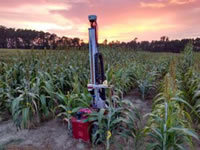How Sensors, Robotics And Artificial Intelligence Will Transform Agriculture
 Jennifer Kite-Powell, Contributor for Forbes: The world population is expected to reach 9.7 billion by 2050. China and India, the two largest countries in the world, have populations totalling around one billion. In four years, by 2022, India is predicted to have the largest population in the world, surpassing China.
Jennifer Kite-Powell, Contributor for Forbes: The world population is expected to reach 9.7 billion by 2050. China and India, the two largest countries in the world, have populations totalling around one billion. In four years, by 2022, India is predicted to have the largest population in the world, surpassing China.
This means we need new ways to grow food that are smarter and helps regulate our use of land, water and energy in order to feed the planet and avoid a global food crisis. Researchers at Carnegie Mellon University’s Robotics Institute believe the answer lies in sensors, artificial intelligence (AI) and robots.
In a new initiative called FarmView, researchers are working to combine sensors, robotics and artificial intelligence to create a fleet of mobile field robots they hope will improve plant breeding and crop-management practices. Full Article:
Comments (0)
This post does not have any comments. Be the first to leave a comment below.
Featured Product

